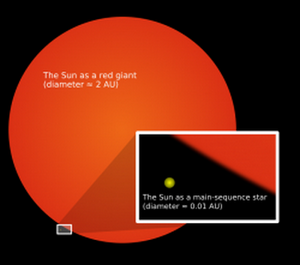Planetary securityEnjoy it while you can: 850 million more years before oceans boil away
Scientists had estimated that the Earth’s oceans would boil away in about 150 million years. The reason: the sun expands as it runs out of hydrogen fuel, and that expansion, 150 million years from now,would cause “runaway” global warming leading to the boiling of the oceans. Scientists have now found that the Earth’s “Goldilocks Zone” — where it is neither too hot nor too cold for liquid to exist on a planet orbiting a star— is slightly larger than previously thought, meaning Earth has bought itself some additional time — about 700 million years – before the oceans evaporate.

The sun as a yellow dwarf and its near-death red giant phase // Source: commons.wikimedia.org
Whilst global warming and increasing pollution have left the words “ocean” and “good news” with very few search results in search engines, a scientist from the University of Toronto has unveiled encouraging data in the journal Nature. According to his findings, the Earth might have another billion years ahead of it before its oceans boil away.
A CORDIS release reports that previous estimates had it that the phenomenon would take place in 150 million years, due to the Earth’s “Goldilocks Zone.” This area, where it is neither too hot nor too cold for liquid to exist on a planet orbiting a star, is slightly larger than previously thought — 0.95 AU (or astronomical unit, the average distance from Earth to the Sun) rather than 0.99 AU.
Until now, scientists feared that the expansion of the Sun as it starts to run out of hydrogen fuel would lead to “runaway” global warming in 150 million years from now. Jeremy Leconte, who led the study, said in an interview with Space.com that “from the perspective of the Earth this is a big change, and it’s because the Earth is thought to be quite close to the inner edge. We now find that it’s not that close.”
Unlike previous one-dimensional studies, the new modeling takes clouds and circulation into account, which puts the inner edge of the habitable zone closer to a star. This buys the Earth a little more time, although the planet is still quite close to the near end of the habitable zone.
In addition to being great news for our descendants, the new model is expected to help scientists better understand what defines a habitable alien planet. “We now have the real framework for understanding these objects not as just dots but as real planets that have a surface, an atmosphere where complex processes like cloud formation can happen like on the Earth,” Leconte said.
— Read more in Jérémy Leconte et al., “Increased insolation threshold for runaway greenhouse processes on Earth-like planets,” Nature 504 (12 December 2013): 268–71 (doi:10.1038/nature12827)
